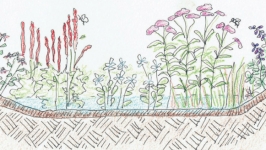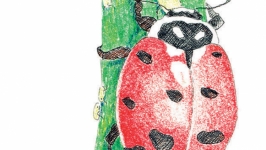Fall Yard Clean-Up
Leave the leaves this fall
Fall is the winding down of my gardening season. Time for me to start my fall cleanup. I do it much less obsessively these days. Here’s why: Fall is also the time when the insects are winding down for the winter.
Our insect population has decreased approximately 45 percent since the 1970s. Threatened by pesticides and habitat loss, their numbers are still declining. There are some things we can do now to reverse that decline: Be less fanatic about your fall cleanup, and leave the leaves. It is where tons of insects overwinter—as adults, caterpillars, chrysalises, or eggs.
I used to be ruthless in my fall cleanup. I like things tidy. I’d cut back all my perennials and grasses to five inches, rake all the leaves and debris out of beds and drag them to the street for the town to pick up. My garden beds were left neat and clean for winter. And sterile. While this gave me a sense of accomplishment and left my garden looking well groomed, I was not doing right by our small insect friends and birds. Not to mention my plants or the soil. Removing all that organic matter was taking away a great source of nutrients for my plants. I was also tossing out the butterflies I work so hard to attract in the spring.
Fall detritus, leaves, decaying plant material, and mulch are essential to insects and butterflies. It’s where they overwinter. Caterpillars roll themselves in leaf litter for protection from cold and predators. Red-banded hairstreak butterflies use fallen oak leaves to lay their eggs, then the caterpillars eat the leaves when they emerge. While monarchs migrate to Mexico, luna moths and swallowtails smartly camouflage their cocoons and chrysalises as dried leaves. These will hatch and mature before bad bugs like aphids arrive, and they are your first line of defense against them.
FALL DETRITUS, LEAVES, DECAYING PLANT MATERIAL, AND MULCH ARE ESSENTIAL TO INSECTS AND BUTTERFLIES. IT’S WHERE THEY OVERWINTER
Many other garden protectors, including ladybugs, wait out winter in the leaves and plant material left in place. Ladybugs eat 50 aphids a day or 5,000 in a lifetime! Ground beetles, green lacewings and damsel bugs take care of slugs, whiteflies, mites, and cabbage worms.
Leave some of the late-season weeds, too. The ubiquitous clearweed and stinging nettle are host plants for many butterflies, like the beautiful red admiral. Some bugs lay their eggs in the stems of native perennials, especially in ones with hollow stems, like goldenrod.
Birds are another reason to clean up less come fall. While adult chickadees feed mostly on seeds, they feed their chicks almost exclusively caterpillars. If there are not enough caterpillars, chickadees cannot reproduce. We know that, while chickadees can live to be up to 13 years old, they only have a 25 percent chance of making it through their first year. The biggest threats are predators and starvation. So, cleaning up too well can deny them a huge food source.
I leave perennial and grass seed heads alone in fall as they provide the birds much-needed food in winter. Coneflowers, coreopsis, beard tongue and sedum seeds are great food sources once they mature. Blue jays, cardinals and finches stop by to feed, entertaining me with their antics.
I let the leaves that fall into my garden bed remain there whole; they may already be harboring eggs and caterpillars. I shred leaves that land on my lawn and add those in the garden beds, too. I just pile them up and run over them a few times with my mower. This process creates a great winter mulch that is fluffy enough to protect many species. Not only am I not destroying habitat, I am also providing organic matter to my beds, so I won’t need as much mulch in the spring. The area directly below an oak tree is critical, as oaks are the number one home for caterpillars, and the detritus at their base is full of overwintering bugs.
If the idea of an untidy garden does not sit well with you, pick one bed less visible from your window and dedicate it to mess. There you can trade in your compulsive garden habits for a few ecosystem services that the “mess” will provide. When you leave the full fall cleanup till spring, you help the bugs that will help you out later.
I call this grateful exchange. When we support our gardens with organic matter, we feed the soil that in turn feeds our plants. “Leave the leaves” is a good motto. We remove loads of organic matter from our property when we rake our leaves to the street, only to bring in mulch after winter.
‘Come spring, I wait as long as I possibly can to finish the cleanup. After we’ve had a few warm days, I remove the unsightly dead plant material and undecayed leaves to my compost pile and get on with my spring gardening, knowing I helped thousands of insects survive the winter.
FALL GARDEN CHORES
These seven steps will ensure a healthy future for your lawn and garden:
- Seed any bare lawn areas, but be thoughtful not to over seed. Too much seed creates crowded plants and invites fungus.
- Aerate your lawn using a rented core aerator, especially in high-traffic areas. This will pull out soil plugs two to three inches deep, allowing nutrients, air, and water to penetrate. Do this when soil is moist. Seed right after and add compost or compost tea. Leave plugs to decompose.
- Wrap young trees to keep deer from using them as scratching posts. They’ll strip the bark and kill your tree! Instead of ugly plastic, Edwina von Gal of PRFCT EARTH PRJCT uses twine. Wrap loosely around the trunk “barbershop pole style” from about four feet high down. Remove in the spring or let it rot away.
- Water your garden well, then turn off your irrigation for the winter.
- Leave the leaves to insulate and feed the soil. Mulch them with your mower if they are in the lawn; just leave them whole in your planting beds. Shredded leaves don’t provide the same cover for eggs and caterpillars, but they will break down quickly in the lawn and fertilize your soil.
- Put down your pruners. Don’t polish off a whole population of insects that will be overwintering in your garden. Don’t cut back canes, stalks, and other standing plants. Protect the insects’ habitat all winter and they will reward you in spring by serving as early pollinators, and by eating aphids and other nuisance bugs.
- Put up a sign that says: “Pollinator Habitat.” I am being sarcastic, but I bet it will quiet up your neighbor who has a suspiciously green chem-lawn and stares down your “mess.” Etsy has some great ones.









